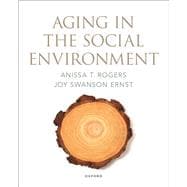Aging in the Social Environment examines the aging process from micro, mezzo, and macro lenses. The micro lens looks at individual processes of aging such as biological, emotional, spiritual, and psychological factors along with topics such as health, resilience, sexuality, and creativity as we age. The mezzo lens looks at processes beyond the individual including work, roles, family, caregiving, living arrangements, religious involvement, and health care. The macro lens looks at factors such as culture, media, laws, policies, language, and stereotypes about aging.
Chapters integrate information from an intersectional perspective: topics are discussed examining factors such as age, class, race, ethnicity, geography, culture, gender identification, and sexual orientation. Also, topics are approached using queer, feminist, and strengths-based approaches instead of a problem-based approach, as used in most texts. These approaches help students to critically think about current, entrenched attitudes about aging and to look at aging processes from different perspectives. It gives attention throughout on the use of language and stereotypes for the aging process, and incorporates new, strengths-based language (e.g., third age) to provide readers with alternative ways of thinking and talking about aging. Finally, the book is organized using a human development approach to integrate aging more thoroughly with the entire developmental process rather than treating it as a separate, distinct process in human development that occurs at the end of life.








